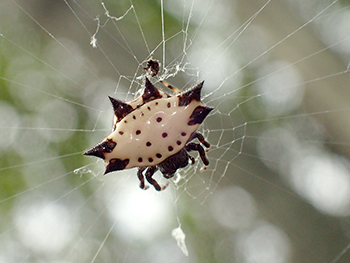Aruba and Curaçao do not have large hairy spiders like the feared Tarantulas in South America, but they do have a large number of other species, most of which are so small that they are hardly noticeable. Most spiders on the islands are well camouflaged and ‘disappear’ in their natural environment. They are mainly brownish and greyish in colour and therefore do not stand out against the same brownish and greyish colours that are mainly seen in nature.

However, when the rain starts to fall and the plants and trees are wrapped in their fresh green suits with brightly coloured flowers, it becomes noticeable that there are a few things crawling around that have eight legs and are called spiders. The most striking spider that ‘suddenly’ appears during this period and starts spinning spider webs enthusiastically by the dozens is the so-called Spiny Orb Weaver in English which is related to the Gasteracantha. The name spiny spider says enough about the appearance of the animal. It is an angular looking animal with spines on its abdomen that give it the appearance of a cactus. The web of these animals is spectacular to see, especially with drops of morning dew on it. The speed with which they construct that web is spectacular. Every time a fly or butterfly flies into the web with a lot of ‘force’, a large piece of the web is destroyed. However, within an hour it is woven back together by the animals. The insect that was so unfortunate to fly into the web is wrapped in spider silk in no time and usually kept until the spider is hungry. In the meantime, the enzymes that the spider injected into the victim ensure that it is internally digested into a jelly that is easy for the spider to suck up, handy if you don’t have teeth. Spiny spiders can grow quite large, think of 3 centimeters in diameter.
Many species are known all over the world, for Aruba and Curaçao and other islands in the Caribbean the species is called Gasteracantha cancriformis, a yellow spiny spider. But besides this common yellow variant, we have also encountered orange, light blue and white spiny spiders in the garden that look clearly different.
English name: Spiny-backed Orb Weaver / Siny Orb Weaver
Papiamentu name: Araña
Scientific name: Gasteracantha cancriformis
Occurrence (ABC islands): Curaçao, Aruba

Stekelige spinnen
Aruba en Curaçao hebben geen grote harige spinnen zoals de gevreesde Tarantula’s in Zuid-Amerika, maar wel een groot aantal andere soorten, waarvan de meeste zo klein zijn dat ze nauwelijks opvallen. De meeste spinnen op de eilanden zijn goed gecamoufleerd en ‘verdwijnen’ in hun natuurlijke omgeving. Ze zijn voornamelijk bruinachtig en grijsachtig van kleur en vallen daarom niet op tegen dezelfde bruinachtige en grijsachtige kleuren die vooral in de natuur te zien zijn.
Wanneer het echter begint te regenen en de planten en bomen in hun frisse groene pakken met felgekleurde bloemen zijn gehuld, valt het op dat er een paar wezens rondkruipen die acht poten hebben en spinnen worden genoemd. De meest opvallende spin die in deze periode ‘plotseling’ verschijnt en enthousiast spinnenwebben bij tientallen begint te spinnen, is de zogenaamde Spiny Orb Weaver in het Engels die verwant is aan de Gasteracantha. De naam stekelspin zegt genoeg over het uiterlijk van het dier. Het is een hoekig uitziend dier met stekels op zijn achterlijf die hem het uiterlijk van een cactus geven. Het web van deze dieren is spectaculair om te zien, vooral met druppels ochtenddauw erop. De snelheid waarmee ze dat web construeren is spectaculair. Elke keer dat een vlieg of vlinder met veel ‘kracht’ in het web vliegt, wordt een groot stuk van het web vernietigd. Binnen een uur is het echter weer door de dieren aan elkaar geweven. Het insect dat zo ongelukkig was om in het web te vliegen, wordt in een mum van tijd in spinnenzijde gewikkeld en meestal bewaard tot de spin honger heeft. Ondertussen zorgen de enzymen die de spin in het slachtoffer injecteert ervoor dat het inwendig wordt verteerd tot een gelei die de spin makkelijk op kan zuigen, handig als je geen tanden hebt. Stekelspinnen kunnen behoorlijk groot worden, denk aan 3 centimeter in diameter.
Er zijn wereldwijd veel soorten bekend, voor Aruba, Curaçao en andere eilanden in het Caribisch gebied heet de soort Gasteracantha cancriformis, een gele stekelspin. Maar naast deze veel voorkomende gele variant zijn we in de tuin ook oranje, lichtblauwe en witte stekelspinnen tegengekomen die er duidelijk anders uitzien.
Nederlandse naam: Gele stekelspin
Papiamentse naam: Araña
Wetenschappelijke naam: Gasteracantha cancriformis
Voorkomen (ABC eilanden): Aruba, Curaçao